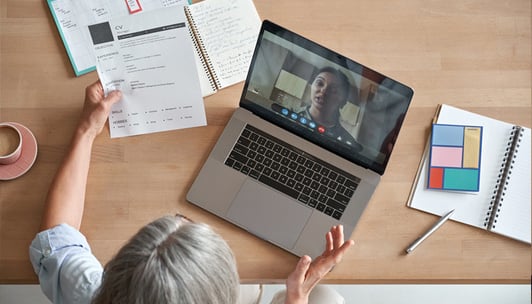5 ways to do better remote hiring

2020 is finally behind us, but COVID-19 will be with us for a while longer yet! As more and more recruitment is done remotely, businesses are moving to video recruitment. But how can you make it work better for you?
Here are our top tips for getting it right.
#1 Adapt your process to suit video
In the early days of remote working, video was used to simply replace face-to-face interactions, but when it comes to your interviewing, it pays to adapt your process and make use of what the right tools can offer.
Recognising that this is a whole new interview process, not just a replacement, is the first step to getting it right. When hiring for an executive role, you may have had up to ten interactions with the candidate to get a feel for their fit. Some of these might have been casual catch-ups with no real fixed agenda, which might have worked well over coffee, but with video, you really need a clear objective for each interaction, leading you to the point where you can make an informed decision.
#2 Get the right video tech
It’s likely video interviewing will be the state of play for some time to come, so it’s worth investing in tools that make your job easier.
There are some great tools out there, like Alcami, which is best-in-breed video interviewing technology. From pre-screening candidates to recording, filing and indexing conversations so you can find and share individual responses without reviewing the whole interview again, they can really add value.
If you are looking for an option that integrates with an Applicant Tracking System (ATS), local provider Turbo is one to take a look at. Built for the Australian market with local support, it’s an interactive relationship management solution that offers some excellent intelligent candidate screening tools.
#3 Give your candidates an idea of the culture
Cultural fit has always played a critical role in the success of a new hire, and this is still true (or maybe even more so!) when people are working remotely. With the traditional face-to-face interview, the candidate would be onsite, seeing the culture in action, taking cues from what people are wearing, how they talk to each other and the office layout. But it’s actually really hard to give people a taste of this when they are looking at heads on a screen.
Overcommunication is key here – let people know if the way people work, dress and communicate is casual or formal, whether that changes in the hierarchy, and how you maintain the culture in a remote world. This isn’t just helpful for you to ensure candidate fit – it goes both ways. Candidates who don’t like what's on offer have the opportunity to opt-out early and save you the headache of making the wrong hire.
#4 Prepare candidates for each video call
In the face-to-face world, the type of interaction would give candidates an indication of what to expect, e.g., coffee chat vs. panel interview. Inviting someone to a video call doesn’t offer any insight.
It might sound simple, but the rulebook has been thrown out the window, so giving them a heads up is important. Let them know the dress code, a reminder of the kind of background to use (e.g., a neutral background, not their unmade bed!), and who will be there. It’s also helpful to let them know if the other attendees will be in a room together or in different locations, as this can really change the dynamic.
Even if it feels like overkill, you’ve progressed someone to a video chat or interview because you’re genuinely interested in what they offer your business, so it pays to ensure they can put their best foot forward.
#5 Make the most of references
When you haven’t met a candidate face-to-face, references are even more critical. But from the inevitable phone tag to making sure the reference is genuine, it can be a nightmare.
Referoo’s online reference checking tool is designed to make the process more efficient, secure and valuable. You have time to pre-plan and structure your questions, and the referee has time to think about their responses when they can give it their full attention. This will ultimately give you more quality input that can be the difference between the right and wrong hire.
And reference-checks can be used for more than simply avoiding a wrong hire. With just a couple of well-selected questions, you can gain first-hand insight from your new recruit's previous managers around how they respond to teamwork, targets, pressure, and being managed. This gives you a head start in understanding how to best manage and communicate with someone who won’t be physically working with their manager.
Get your remote hiring process right, and you can not only save time and money but find the right candidates faster. How is remote recruitment and reference checking working for you? Drop us a line; we’d love to hear from you.